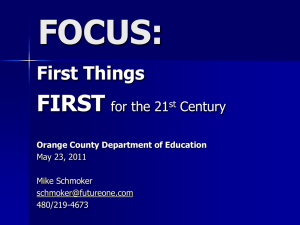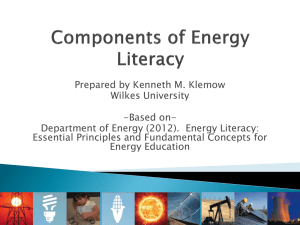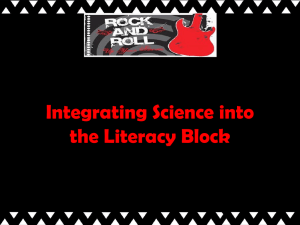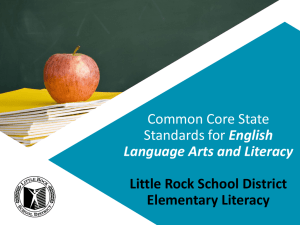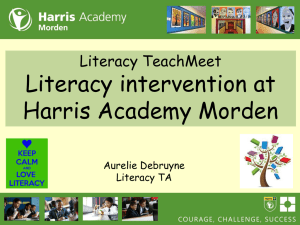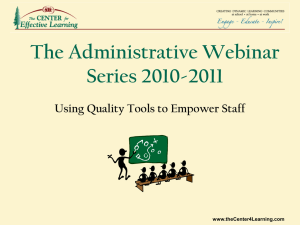Click to Dr. Schmoker`s FOCUS PowerPoint presentation.
advertisement
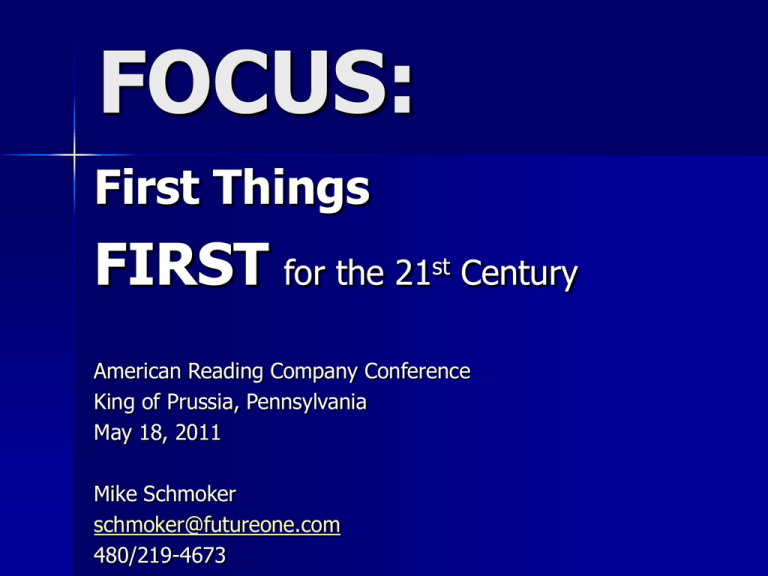
FOCUS: First Things FIRST for the 21 st Century American Reading Company Conference King of Prussia, Pennsylvania May 18, 2011 Mike Schmoker schmoker@futureone.com 480/219-4673 Sometimes the first duty of intelligent men is the restatement of the obvious. George Orwell No one has the right to waste a day in the life of a child. Principal quoted by Karen Chenoweth, EdTrust A Day in the Life… English Language Arts Social Studies Science Math ALL subjects: worksheets RESULT..? 25-30% 20% 7% Solution…? FOCUS on “first things” 1. SIMPLICITY/LESS is MORE: first things + clarity + ceaseless reinforcement = guaranteed results 2. FIRST THINGS-simplified 3. FIRST THINGS —in 4 Subject Areas SIMPLICITY: Is Less Really …MORE? ”Foxes pursue many ends at the same time…Hedgehogs see what is essential, and ignore the rest.” Good to Great p. 91 Jim Collins Which most effective? (re: test scores; college/career sucess) Laptops for all/Smartboards in every classroom Common, content-rich curriculum ALL existing Math/literacy “programs” Differentiated instruction Smaller classes Cold calling (and other “checks for understanding”) Various small/school-within-a-school “Academies” 90-120 minutes of purposeful reading & writing per day “Turnaround” strategies (new faculty; school design etc.) Cognitive/concept mapping; graphic representations Which most effective? (re: test scores; college/career success) Laptops for all/Smartboards in every classroom Common, content-rich curriculum ALL existing Math/literacy “programs” Differentiated instruction Smaller classes Cold calling (& other “checks for understanding”) Various small/school-within-a-school “Academies” 90-120 minutes--purposeful reading/writing a day “Turnaround” strategies (new faculty; school design etc.) Cognitive/concept mapping; graphic representations FIRST THINGS: Less is MORE but…we keep adding MORE/NEW methods, strategies workshops, terms programs, requirements, technology classroom arrangements… BEFORE implementing “first things” M. Buckingham; J. Collins; Pfeffer & Sutton A FAILURE IN LEADERSHIP “Every time the ______ goes to a conference, the teachers get worried, because they know he’s going to come back with something he wants to try.” Tom Guskey FOCUS: Borax—safety FIRST Hospital—life-saving solution Flowing Wells S.D./Orange Grove M.S. (both in Tucson, Arizona) II. ”First Things” Simplified REASONABLE IMPLEMENTATION OF: 1. Guaranteed Curriculum 2. Authentic, College-prep Literacy 3. Effective Lessons ONCE FULLY MASTERED, we may judiciously pilot evidence-based innovations “GUARANTEED & VIABLE CURRICULUM” NUMBER ONE factor (Marzano) “Content-rich curriculum” learned primarily through purposeful reading/writing (Hirsch; D. Willingham; David Liben) “viable” curriculum = more time for reading; writing; talking @content = gains in reading, college preparation Do America’s schools now ensure that a coherent, “guaranteed,” literacy-rich curriculum actually gets taught? GUARANTEED, CONTENT-RICH CURRICULUM? BRUTAL FACTS: ROSENHOLTZ: teachers provide a “self-selected jumble” of standards BERLINER/WALBERG: wild variation from teacher to teacher; no alignment with agreedupon curriculum/standards GOODLAD; LITTLE; SIZER; ALLINGTON; CALKINS: “curricular chaos" in Eng./Language arts Common Core standards: BETTER, but… STILL need to be reduced/clarified (Reeves; Ainsworth; Schmoker) NEVER PILOTED (Conley/Ravitch) SO: until Common Core assessments arrive… CURRICULUM/LITERACY CURRICULUM CONTENT learned via reading, writing, discussion in these modes: draw inferences and conclusions analyze conflicting source documents solve complex problems with no obvious answer support ARGUMENTS with evidence Multiple 3-5 page papers & “far more books, articles & essays” College Knowledge by David Conley CURRICULUM MAP Essential 50-60% of standards/topics – Divide by grading period (approximate time per standard) Select Common READINGS (for each standard—to discuss and write about) – Textbook: specific pages for each topic (vs. chapters) – Hist./Sci. documents; news/magazine articles; data sets – Generate questions/tasks for each reading to argue; infer; resolve conflicting texts; problem-solve Define parameters for Common WRITINGS – Number/length (e.g. Two 3-4 page papers a semester) Identify topics for “Interactive Lecture” where students frequently note-take; review notes; discuss 2. AUTHENTIC LITERACY Literacy is “the spine that holds everything together in all subject areas …” Phillips & Wong, Gates Foundation E.D. Hirsch Rafe Esquith Thomas Friedman AUTHENTIC LITERACY? “Reading & Writing vs. ‘stuff’ ratio” (Allington) “Literature based Arts and Crafts” (Calkins): – dioramas; game boards; worksheets; posters; coats-of-arms; mobiles; movies; cutting, gluing; coloring; drawing; designing book jackets; skits; collages FAUX LITERACY Learn about (__ grade): Irregular plurals Silent e I before e Words ending in –y; -ed; -ing 8th grade: Ms. Brill was disappointed when (a., b., c., or d.?) Ms. Brill’s fur collar is a symbol of (a., b., c., or d.?) FAUX LITERACY Compare & contrast structure of texts and analyze how the differing structure of each text contributes to its meaning and style Analyze how the points of view of the characters and audience or reader (e.g. created through the use of dramatic irony) create effects like suspense or humor 8th grade Common Core--Reading ALTERNATIVE: --50-80% of CURRICULUM -READ, DISCUSS & WRITE ABOUT INCREASINGLY COMPLEX FIC/NON-FIC TO: draw inferences and conclusions analyze conflicting source documents support ARGUMENTS with evidence solve complex problems with no obvious answer (all in common core) READ “far more” books, articles & essays” WRITE multiple 3-5 page papers every year College Knowledge by David Conley WRITING: HOW IMPORTANT? “There are no silver bullets in education. But …non-fiction writing is about as close as you can get to a single strategy that has significant effects in nearly every area of the curriculum.” Doug Reeves “If we could institute only one change to make students more college ready, it should be to increase the amount and quality of writing* students are expected to produce.” David Conley College Knowledge LITERACY TEMPLATE: ACROSS THE CURICULUM (up to 80% of curriculum, in ALL subjects) I. TEACH VOCAB./Provide background of text --Provide question or prompt: II. ”MODEL” critical reading/underlining/annotating --Students individually annotate 1-3 paragraphs --pair/share annotations…as teacher continuously “checks for understanding” III. REPEAT above until…? IV. DISCUSS: in pairs/small group as a class V. WRITE: short/long; scored— or not SIMPLE, college-prep literacy Rafe Esquith Tempe Prep View Park H.S. Lynn Abeln 3. EFFECTIVE LESSONS… Clarified All teachers and administrators in a district or school building should be able to describe effective teaching in a similar way. Robert Marzano EFFECTIVE LESSONS and “INTERACTIVE LECTURE” Clear standard/backward design (revise paper for “word choice”; apply mean, median, mode) Teach; model/”think aloud” Guided practice--& lots of think/pair/share) Multiple checks for understanding (“formative assessment”) Independent practice/assessment Hunter; Popham; Marzano; Fisher & Frye; Lemov; Burns; Archer; Wiliam IMPACT of such lessons…? “Largest gains ever recorded” in the history of educational research (Popham) 3 consecutive years: life-changing gains— – 35-50 percentile points DYLAN WILIAM: – Extra 6-9 months per yr./400% faster learning – 20-30 x as effective as the most popular current initiatives (like…?) Ohio State; Sean Connors SIMPLE, EFFECTIVE LEADERSHIP in the Professional Learning Community “No institution can survive if it needs geniuses or supermen to manage it. It must be organized to get along under a leadership of average human beings.” Peter Drucker MONITOR 1. INSTRUCTION and 2. COMMON, COLLEGE-PREP CURRICULUM LEADERS (administrators, dept. heads) must 1. Conduct at least one unannounced classroom walk-through each month, looking for patterns* of strength/weakness with regard to… – Clear focus on essential standards – College prep: critical reasoning/higher-order reading, writing, thinking – Essential elements of an effective lesson (e.g. “check for understanding”) *September:”4/15 teaching essential curriculum” LEADERSHIP: Team Management (D. Reeves; R. Marzano; R. DuFour) QUARTERLY CURRICULUM REVIEW: Leaders & Teams discuss… quarterly/unit assessments (success rate; areas of strength/weakness) scored areas) papers/projects (weak/strong CONCLUSION: SIMPLE WHAT: core content, learned through college-prep reading, discussion and writing + HOW: reasonably effective lessons delivered consistently, in every classroom/subject area = RECORD NUMBERS of successful students OUR CHOICE: DO WE WANT… 20-30% ready for college/careers 80%+ ready for college/careers III. ELEVATING THE ESSENTIALS in the Core Disciplines LANGUAGE ARTS CURRICULUM GENERATE COMMON LIST/NUMBER OF: quality fic/non-fic books (10-15?) plus articles, poems, etc. --divide by grading period papers* of ___ length (per grading period) for all of above: generate questions/tasks to argue; infer; resolve conflicting texts; problem-solve (College Knowledge) FOR ALL ABOVE: LESSONS/MODELING on HOW TO: Underline/annotate; cite & explain supporting text participate in Socratic discussions …hundreds of times per year, 2nd-12th grade *PAPERS AS PRIMARY ELA ASSESSMENTS SOCIAL STUDIES CURRICULUM Literacy is the key word; the teaching of history should have reading and writing at its core. Sam Wineburg, Stanford University Social Studies Stud SOCIAL STUDIES CURRICULUM MAP Essential 1/2 to 2/3 of standards/topics Select Common READINGS (for discussion and writing) – Textbook: specific pages for each topic (vs. chapters) – Historical/primary/current documents (___ per week?) – Generate questions/tasks to argue; infer; resolve conflicting texts; problem-solve (College Knowledge) Define parameters for Common WRITINGS – Number/length (e.g. Two 3-4 page papers a semester) Identify topics for “Interactive Lecture” --i.e. note-take; review notes; discuss every few minutes Build Common quarterly/unit assessments (50+ % written/essay format) SCIENCE CURRICULUM “Being science literate entails being able to read and understand a variety of science texts to form valid conclusions and participate in meaningful conversations about science” National Research Council 2008 SCIENCE CURRICULUM MAP CORE CONTENT/UNITS & LABS by grading period (with common quarterly/unit assessments) SELECT COMMON READINGS: Textbooks (selected pgs.); 20-30 science articles (TIME for Kids; The WEEK, e.g. theweek.com/article/index/27340/breifing-rethinking-nuclear-power ) TEACH/MODEL (i.e. “think-aloud”) --in-class reading/note-taking; --discussion/debate; write to explain; argue; resolve; problem-solve Identify topics for Interactive Lecture (note-take; review notes; discuss in pairs) Create common assessments (50+% written) Writing/note-taking in Science: from 25% 90% success; D.Reeves) MATHEMATICS CURRICULUM Math teachers need to focus on the interplay of numbers and words, on expressing quantitative relationships in meaningful sentences. To make mathematics meaningful, all three Rs must be well blended in each student’s mind Lynn Steen 21st Century Mathematics Map Core Content by grading period Identify opportunities to explain, apply, solve openended/extended-response problems orally & in writing Select readings from: math text (pages/word problems); data sets (sports; demographics; news/magazine articles, e.g. “Best.Decade.Ever.” by Charles Kenny) and write about them Always teach with FREQUENT think/pair/share and “checks for understanding” (Burns) Math: Read, Write, Talk “I can no longer imagine teaching math without making writing an integral aspect of students’ learning.” Marilyn Burns Math: Read, Write, Talk READ: Teach/model close reading of math text/word problems (Shanahans) WRITE (from Marilyn Burns): I think that the answer is _____ . I think this because ______. I figured this out by ____ DISCUSS: in pairs whole class FOCUS Describe/explain impact of “first things” Clarify, Clarify, Clarify Monitor & measure implementation in simple, time-efficient ways Clarify/Repeat/reinforce incessantly Improve in team-based PLCs FIRST… REVIEW/REDUCE “BRAND NAME” PROGRAMS, which often interrupt coherent curriculum are multiple choice/worksheet-driven reduce time spent reading complex text impede implementation of FIRST THINGS READ, TALK and WRITE in response to lit./non-fiction EVALUATE CHARACTERS/LESSONS/THEMES: – – – – Jack & the Beanstalk Stone Fox; Harry Potter Kite Runner; Hills Like White Elephants Non-fiction: Night; 3 Cups of Tea ARGUE/INTERPRET --Because I Could Not Stop for Death (Poem) --Best. Decade. Ever. (Essay by Charles Kenny) EXAMPLES: Social Studies “CLOSE READING” TEXTBOOK (selected pages) (Elementary) Would you prefer to be a Mayan or an Aztec (pp.12-16)? (Middle/H.S.) Make case for the South in Civil War (pp.443—467) PRIMARY SOURCE DOCUMENTS Do you Agree/disagree: General Sherman on “Total War” Plessy v. Ferguson--majority opinion NEWS/EDITORIALS/MAGAZINES (TIME for Kids) PRO-CON: Afghan war; health care; “Best. Decade. Ever.” (C. Kenny) SCIENCE: “Task, Text and Talk” TEXTBOOK: Explain similarities and differences between plant & animal cells; meiosis/mitosis (explanation/argument) TEXTBOOK/ARTICLES: Cite text to argue for/against @ current problems/issues (stem cells; nuclear energy; gum-chewing; multi-tasking) --in TIME for Kids; The WEEK) TEAM TASKS Write student-friendly learning targets/objectives Help each other find/select readings – Develop good questions/prompts for readings Develop effective anticipatory sets/advanced organizers Identify and address anticipated difficulties in learning targets Develop common unit/lesson assessments Refine “interactive” lecture/s (note-taking; discussion; review of notes etc.)
